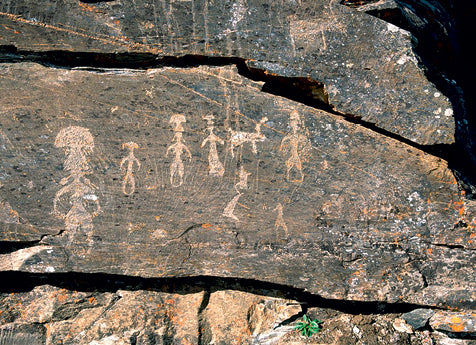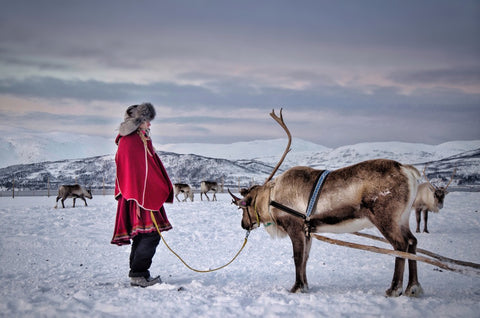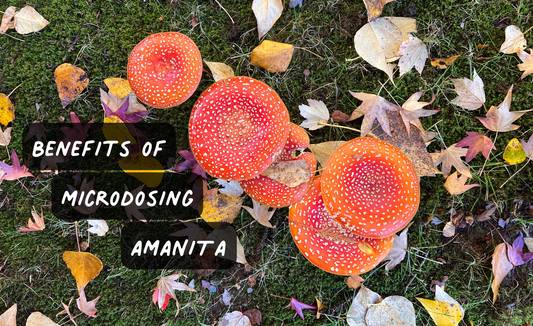Journal Contents:
- Intro
- When was Amanita first used by humans?
- Amanita in Archeology
- Tribal Use
- Connection with Christmas
- Soma: The drink of the Gods?
- Cultural Removal of Amanita
- Loss of Knowledge
- Modern Renaissance
Intro
You most likely have seen this mushroom in pop culture. From the story behind Alice in Wonderland, to the mushrooms in Mario, all the way to the mushroom emoji on your phone, Amanita muscaria (Amanita) makes herself known. But little is known about Amanita to most people, and what is known has been distorted from years of misinformation. This website, and the blog post that follows are an effort to help change that.
When was Amanita first used by humans?
The first recorded use of Amanita goes back 50,000 years with a cave painting in Australia. Since we know that Amanita spread from Siberia down to Australia, we can make an educated guess that Amanita has been used by humans for far longer, and thus can be claimed to be the first or one of the first entheogenic mushrooms consumed.
Amanita in Archeology
Most evidence of amanita's use in history is via rock art that depicts (red) mushrooms with spots, or mushrooms with bulbous bottoms (unlike the psilocybe species which are depicted with wavy caps or blue stems). Oftentimes rock art represents religious or shamantic motifs, and thus depictions of amanita represent a spiritual connection with the mushroom.
 credit: Siberian Times "fly agaric people"
credit: Siberian Times "fly agaric people"
Amanita-like carvings have been found all around the world including: Mexico, France, India, Siberia, North Africa, and Spain. Either each culture discovered the magic of Amanita independently, or they shared the knowledge as they migrated.
Tribal Use
Amanita use in history is well documented in Siberia. There it was used seasonally to keep spirits up through dark winters and for spiritual rituals by shamans. Traditionally Amanita was harvested in the Fall when it was fruiting, and then hung to dry above a fireplace for 3 months. By December, the mushroom was ready to be boiled into a tea and consumed during winter festivities.
Additionally, some shamans would feed amanita to reindeer to allow them to decarboxylate the ibotenic acid to muscimol in their gut and then collect their urine afterwards to drink.
 credit: microdose.buzz
credit: microdose.buzzOther cultures had similar, but unique relationships with the mushroom.
- Some tribes would only allow shamans to work with amanita. They would consume large amounts of the mushroom, have visions, and then educate the rest of the tribe about the lessons they learned from Amanita.
- In others, shamans would detoxify the mushroom in their body and then pee out a safer drink that others could consume.
- Some individuals would pick their own mushrooms and then consume small dried pieces throughout the year.
Connection with Christmas
The traditions of early shamans drinking reindeer pee and hanging mushrooms to dry on a trees are baked into our modernday Christmas celebrations. Over time, these winter celebrations of the northern people were adopted by Catholic and Christian churches
 credit: USDA Forest Service
credit: USDA Forest Service
Today threads remain of the ancient shamanic ritual:
- Santa replaced the shaman
- Santa's bright red cheeks represent the warmth one gets from consuming larger doses of amanita
- The reindeer represented the flying sensation one gets, and the ties to reindeer drinking Amanita mushroom
- Christmas trees were the pine trees amanita are commonly found beneath
- Ornaments replaced the mushrooms being hung to dry
Though the ruby red mushroom doesn't grace our dinner tables anymore, the cultural history remains tied to the most widespread celebration on earth.
Soma: The drink of the Gods?
Cultural Removal of Amanita
Just like other psychoactive substances in history, prohibiting Amanita’s use was seen as a way to disenfranchise tribal people and rogue “cults”. Having spiritual connections with a mushroom and not with God was seen as a threat to churches and over time Amanita’s use was looked down upon.
A good example is with amanitas relationship with beer.
Before 1516, Amanita was commonly to used in the making of beer, creating an amalgam of the traditional wintertime tea and alcohol. Both alcohol and beer affect GABA in the brain and so people enjoyed the relaxed and euphoric feeling it gave.
 "Reinheitsgebot" credit: wikipedia
"Reinheitsgebot" credit: wikipedia
However, in 1516, the Beer Purity Law (also called Reinheitsgebot) was enacted, creating strict rules around what could and could not be added to beer - specifically only water, barley and hops. Amanita beer was thus illegal and so its use was ostracized to small villages in northern Europe.
Loss of Knowledge
Knowledge of how to safely prepare amanita through decarboxylation was lost with time: Those who stumbled upon a ruby red mushroom in the forest and took to eating it were met with an upset stomach and wild visions. Over time, news about the negative side effects spread and Amanita was named a toxic mushroom in mycology books around the world.
 location: Hungary, credit: New York Times
location: Hungary, credit: New York Times
Only those brave enough to look deep into history books revealed the true nature of this magic mushroom.
Modern Renaissance
Today, newfound interest in the healing potential of mushrooms and psychedelics has brought light to psychoactive fungi again, amanita included. Luckily Amanita, unlike its psilocybin-containing cousins, are legal. In the past 50 years, those brave enough have taken the time to reopen the door to our relationship with this magical mushroom. Many have discovered the ultimate secret: when properly decarboxylated, amanita can be one of the most powerful, yet gentle, healers of trauma and lifelong anxiety.
Our mycelial ties with Amanita run deep, but in some ways its story has only just begun.













